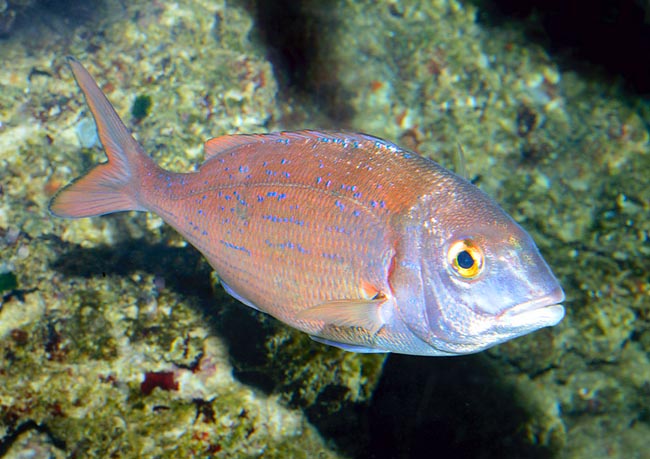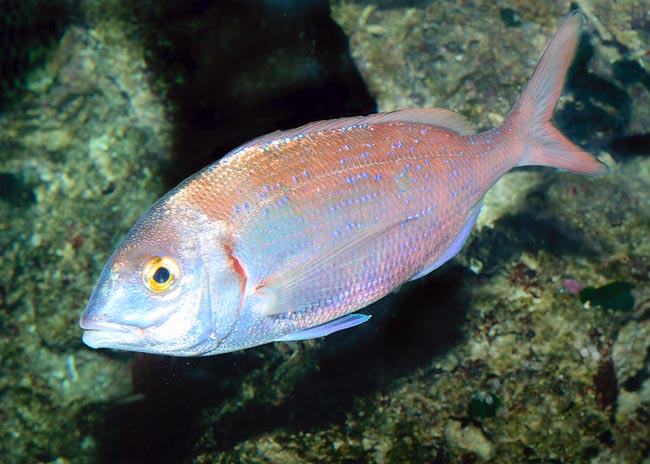Family : Sparidae

Text © Giuseppe Mazza

English translation by Mario Beltramini

Pagellus erythrinus has a vast range from Mediterranean to Scandinavia and to Guinea-Bissau © Giuseppe Mazza
The genus name is the Latin diminutive of the Common seabream (Pagrus pagrus), a quite similar fish, even if usually bigger.
The name of the species comes from the Greek “erythros” = red, with obvious reference to the dominating colour.
Zoogeography
It has a very vast distribution. Common in the whole Mediterranean, is present also in the Black Sea. The, passed the Gibraltar Strait, goes northwards along the Atlantic coasts up to the Scandinavian countries. Southwards, it reaches the Guinea-Bissau, after having colonized the Azores, Madeira, Canaries and Cape Verde Islands.
Ecology-Habitat
It is a coastal benthopelagic species living usually between the 20 and the 100 m of depth, but it can even reach the 300 m. We find it on the clean sandy bottoms, frequented mainly by the juveniles, and the bottoms mixed with rocks, stones and debris, and finally on the muddy-gritty ones, further offshore.
Morpho-physiology
It can reach the 60 cm of length and exceed the 3 kg, but usually measures 20-25 cm. The body, flat as is suitable for a sparid, reaches the maximum height at the insertion of the spine column, and from here the profile goes down, straight, towards the pointed snout.

Dominant colour is the pink with bluish hues and blue dots especially in the reproductive time © Giuseppe Mazza
The only one dorsal fin has 12 spiny rays, foldable in a special groove, and 10-11 soft rays. The anal fin has 3 spiny rays and 8-10 unarmed, and the ventral 1 spine and 5 soft rays. The pectoral fins are triangular and elongated, the caudal is forked. The eye, with yellow iris, is big, for granting a good vision in the darkness of the bottoms.
Pink is the dominating colour, with bluish hues, and many blue small dots, glittering in the upper part of the sides, which become brighter in the reproductive period. The back is darker and the upper margin of the operculum is of red carmine colour. A red spot is noted also, at the base of the pectoral fins. It is easily distinguished from the Common seabream because the tips of the caudal fin are not white.
Ethology-Reproductive Biology
The common Pandora is carnivorous. It nourishes of small fishes and of all the animals living on the seabed. It is a protogynic hermaphrodite species, with females becoming males during the third year of life when they exceed the 1 cm of length. Even if along the Italian coasts it reproduces only in April-May, in the southern Mediterranean it may spawn even twice a year. The post larval stages and the juveniles have a completely different livery with vertical bands. The growth is fast till when they reach the sexual maturity, around the 11-12 cm and then slows down remarkably.
Even if much fished for its excellent flesh, the Pagellus erythrinus not an endangered species. Its population may in fact double in only 1,4-4,4 years. The vulnerability index of this species is of 40 over 100.
Synonyms
Pagellus canariensis Valenciennes, 1838; Sparus erythrinus Linnaeus, 1758.
→ For general information about FISH please click here.
→ For general information about BONY FISH please click here
→ For general information about CARTILAGINOUS FISH please click here.
→ To appreciate the BIODIVERSITY of BONY FISH please click here.
→ To appreciate the BIODIVERSITY of CARTILAGINOUS FISH please click here.
